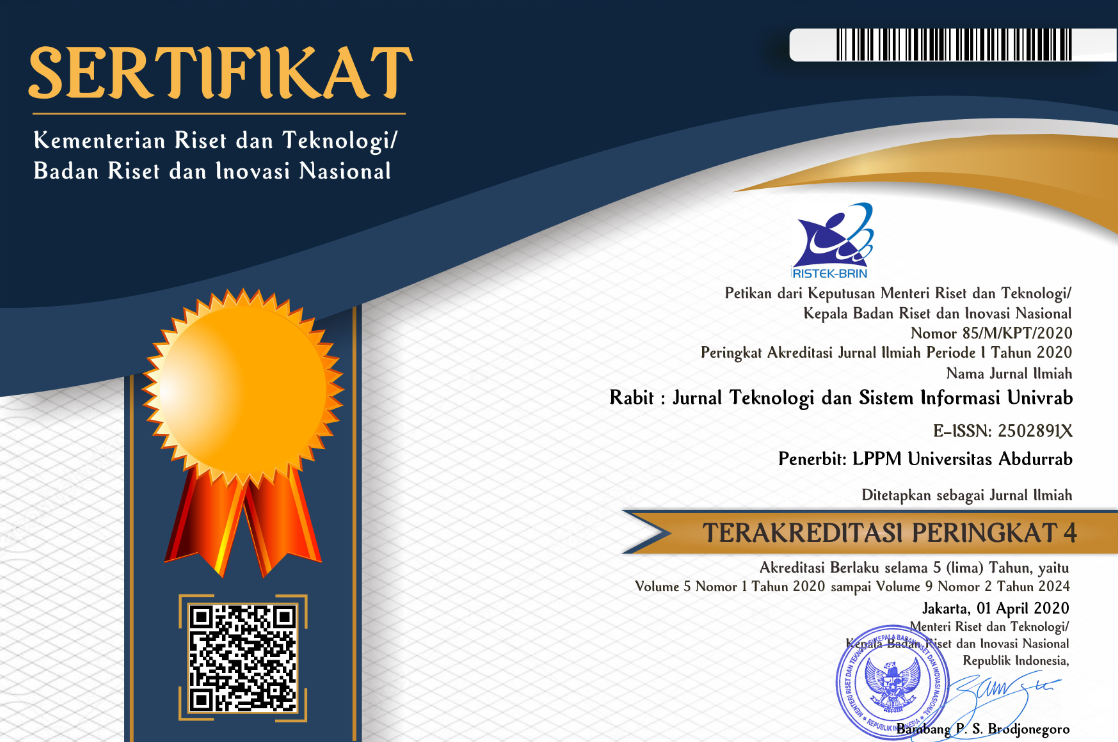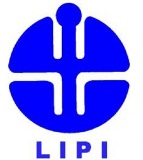PENERAPAN FUZZY ASSOCIATIVE MEMORY UNTUK MENGUKUR TINGKAT KEPUASAN PELANGGAN TERHADAP PELAYANAN PADA TOKO KOPIMA
APPLICATION OF FUZZY ASSOCIATIVE MEMORY TO MEASURE THE LEVEL OF CUSTOMER SATISFACTION REGARDING SERVICE AT THE KOPIMA STORE
Abstract
One of the advantages of information technology in the field of business is that it can help in measuring the level of customer satisfaction. Because measuring customer satisfaction is an important element in providing better, more efficient and more effective services. KOPIMA stores, which is a student cooperative, is experiencing unstable sales problems, this is the result of customer dissatisfaction. There is a system used to measure the level of customer satisfaction with services at KOPIMA stores to find out what are the expectations of customer complaints and how to evaluate service at KOPIMA stores. To measure the level of customer satisfaction with services at KOPIMA stores, the Fuzzy Associative Memory (FAM) method is used. FAM is a flexible decision-making method, which is a fuzzy system that maps fuzzy sets to other fuzzy sets. The output obtained is a web-based system, with the results of the FAM method that can be implemented to calculate customer satisfaction into the rating category, namely 8% satisfied and 92% very satisfied in the November 2022 assessment and December 2022 assessment, namely 4% satisfied and 96% very satisfied . So it can be concluded, customer satisfaction has increased with the assessment criteria being very satisfied with the service at the KOPIMA store.
Downloads
References
W. A. Astuti and M. Marbun, “Jurnal Sistem Informasi dan Teknologi Jaringan Mengukur Tingkat Kepuasan Pelanggan Terhadap Pelayanan Di Toko Lunas Menggunakan Metode Fuzzy Associative Memory,” vol. 2, no. 2, pp. 12–17, 2021.
D. Pranitasari and A. N. Sidqi, “Analisis Kepuasan Pelanggan Elektronik Shopee menggunakan Metode E-Service Quality dan Kartesius,” Jurnal Akuntansi dan Manajemen (JAM), vol. 18, no. 02, pp. 12–31, 2021, doi: 10.36406/jam.v18i02.438.
H. M. Ritonga, D. N. Pane, and C. A. Rahmah, “Pengaruh Kualitas Pelayanan dan Emosional Terhadap Kepuasan Pelanggan Pada Honda IDK 2 Medan,” Jurnal Manajemen Tools, vol. 12, no. 2, pp. 30–44, 2020.
R. A. Malik, S. Defit, and Yuhandri, “Perbandingan Algoritma K-Means Clustering Dengan Fuzzy C-Meansdalam Mengukur Tingkat Kepuasan Terhadap Televisi Dakwahsurau TV,” Rabit : Jurnal Teknologi dan Sistem Informasi Univrab, vol. 3, no. 1, Jan. 2018, doi: DOI : https://doi.org/10.36341/rabit.v3i1.387.
Tugiono, M. K. Situmorang, and A. Azlan, “Implementasi Fuzzy Associative Memory (FAM) Dalam Sistem Pendukung Keputusan Untuk Penentuan Kepuasan Pasien BPJS Kesehatan Terhadap Pelayanan (RSU) Martha Friska Multatuli Medan,” J-SISKO TECH (Jurnal Teknologi Sistem Informasi dan Sistem Komputer TGD), vol. 3, no. 1, pp. 70–77, 2020, doi: 10.53513/jsk.v3i1.197.
S. JS and N. R. Andayani, “Analisis Kepuasan Pelanggan Terhadap Kualitas Pelayanan Di Pt Ramajaya Copier,” Journal of Applied Business Administration, vol. 3, no. 1, pp. 119–131, 2019, doi: 10.30871/jaba.v3i1.1291.
S. Oktamala and E. Zuraidah, “Analisa Pengaruh Kualitas Pelayanan PT Pos Indonesia Cabang Belitang Terhadap Tingkat Kepuasan Pelanggan Menggunakan Metode Servqual,” Jurnal PROSISKO, vol. 8, no. 2, pp. 15–22, 2021, doi: 10.30656/prosisko.v8i2.3702.
M. D. Khairuddin and A. F. Waluyo, “Pengembangan Sistem Informasi Pasien Berbasis Mobile Pada Rsud Sunan Kalijaga Demak Dengan Metode Waterfall,” Rabit : Jurnal Teknologi dan Sistem Informasi Univrab, vol. 9, no. 1, pp. 79–90, 2024, doi: 10.36341/rabit.v9i1.4049.
T. Rukito, D. Suhartono, and Nurfaizah, “Sistem Informasi Pengolahan Arsip Pada Dinas Pendidikan dan Kebudayaan Kabupaten Cilacap,” JIKA (Jurnal Informatika) Universitas Muhammadiyah Tangerang, pp. 78–86, 2020, doi: 10.31000/jika.v4i3.3009.
A. A. Wahid, “Analisis Metode Waterfall Untuk Pengembangan Sistem Informasi,” Jurnal Ilmu-ilmu Informatika dan Manajemen STMIK, pp. 1–5, 2020.
E. W. Wardana, I. R. Munthe, and G. J. Yanris, “Rancang Bangun Sistem Informasi Geografis Pemetaan Hutan Pada Kabupaten Labuhan-Batu,” 2021, vol. Volume 6, no. No. 2, Jul. 2021, doi: DOI : https://doi.org/10.36341/rabit.v6i2.1717.
C. Tristianto, “Penggunaan Metode Waterfall Untuk Pengembangan Sistem Monitoring Dan Evaluasi Pembangunan Pedesaan,” Jurnal Teknologi Informasi ESIT, vol. XII, no. 01, pp. 7–21, 2018.
Y. E. Achyani and S. Saumi, “Penerapan Metode Waterfall Pada Sistem Informasi Manajemen Buku Perpustakaan Berbasis Web,” Jurnal SAINTEKOM, vol. 9, no. 1, p. 83, 2019, doi: 10.33020/saintekom.v9i1.84.
A. Helsalia, H. Pratama, M. Kristiani, and Y. B. Marpaung, “Perancangan Aplikasi Pemesanan Obat di Apotek Dengan Analisis Design UML yang Menerapkan GIS dan LBS,” Jurnal Teknik Informatika : Penerapan GIS dan LBS pada analisis design UML, vol. 1, no. 1, 2021.
A. A. Awalinah, S. P. Arifin, and M. R. A. Saf, “Sistem Pendukung Keputusan Pembelian Mobil dengan Membandingkan Metode Analytic Hierachy Process dan Fuzzy Associative Memory,” Jurnal Nasional Teknologi dan Sistem Informasi, vol. 03, no. 1, pp. 89–100, 2017, doi: 10.25077/teknosi.v3i1.2017.89-100.
Marsono, A. F. Boy, and D. Saripurna, “Sistem Pendukung Keputusan Dalam Menentukan Tingkat Kepuasan Pelanggan Terhadap Pelayanan di Toko Indomaret Menggunakan Metode Fuzzy Associative Memory (FAM),” J-SISKO TECH (Jurnal Teknologi Sistem Informasi dan Sistem Komputer TGD), vol. 3, no. 1, pp. 78–85, 2020, doi: 10.53513/jsk.v3i1.198.
S. D. R and R. Amalia, “Sistem Informasi Pengarsipan Surat Masuk Keluar pada PT . Telekomunikasi Indonesia Tbk,” JBKom (Jurnal Bina Komputer), vol. 4, no. 1, pp. 17–22, 2022.
Copyright (c) 2024 Rabit : Jurnal Teknologi dan Sistem Informasi Univrab

This work is licensed under a Creative Commons Attribution-NonCommercial-ShareAlike 4.0 International License.
Copyright Notice
The copyright of the received article shall be assigned to the publisher of the journal. The intended copyright includes the right to publish the article in various forms (including reprints). The journal maintains the publishing rights to published articles. Therefore, the author must submit a statement of the Copyright Transfer Agreement.*)
This work is licensed under a Creative Commons Attribution-NonCommercial-ShareAlike 4.0 International License.
In line with the license, authors and any users (readers and other researchers) are allowed to share and adapt the material only for non-commercial purposes. In addition, the material must be given appropriate credit, provided with a link to the license, and indicated if changes were made. If authors remix, transform or build upon the material, authors must distribute their contributions under the same license as the original.
Please find the rights and licenses in RABIT : Jurnal Teknologi dan Sistem Informasi Univrab. By submitting the article/manuscript of the article, the author(s) accept this policy.
1. License
The non-commercial use of the article will be governed by the Creative Commons Attribution license as currently displayed on Creative Commons Attribution-NonCommercial-ShareAlike 4.0 International License.
2. Author’s Warranties
The author warrants that the article is original, written by stated author(s), has not been published before, contains no unlawful statements, does not infringe the rights of others, is subject to copyright that is vested exclusively in the author and free of any third party rights, and that any necessary written permissions to quote from other sources have been obtained by the author(s).
3. User Rights
RABIT's spirit is to disseminate articles published are as free as possible. Under the Creative Commons license, RABIT permits users to copy, distribute, display, and perform the work for non-commercial purposes only. Users will also need to attribute authors and RABIT on distributing works in the journal.
4. Rights of Authors
Authors retain all their rights to the published works, such as (but not limited to) the following rights;
- Copyright and other proprietary rights relating to the article, such as patent rights,
- The right to use the substance of the article in own future works, including lectures and books,
- The right to reproduce the article for own purposes,
- The right to self-archive the article,
- The right to enter into separate, additional contractual arrangements for the non-exclusive distribution of the article's published version (e.g., post it to an institutional repository or publish it in a book), with an acknowledgment of its initial publication in this journal (RABIT : Jurnal Teknologi dan Sistem Informasi Univrab).
5. Co-Authorship
If the article was jointly prepared by other authors, any authors submitting the manuscript warrants that he/she has been authorized by all co-authors to be agreed on this copyright and license notice (agreement) on their behalf, and agrees to inform his/her co-authors of the terms of this policy. RABIT will not be held liable for anything that may arise due to the author(s) internal dispute. RABIT will only communicate with the corresponding author.
6. Royalties
This agreement entitles the author to no royalties or other fees. To such extent as legally permissible, the author waives his or her right to collect royalties relative to the article in respect of any use of the article by RABIT.
7. Miscellaneous
RABIT will publish the article (or have it published) in the journal if the article’s editorial process is successfully completed. RABIT's editors may modify the article to a style of punctuation, spelling, capitalization, referencing and usage that deems appropriate. The author acknowledges that the article may be published so that it will be publicly accessible and such access will be free of charge for the readers as mentioned in point 3.
 PDF (Bahasa Indonesia)
PDF (Bahasa Indonesia)
 Abstract views: 16
Abstract views: 16
 downloads: 11
downloads: 11

 :
:












